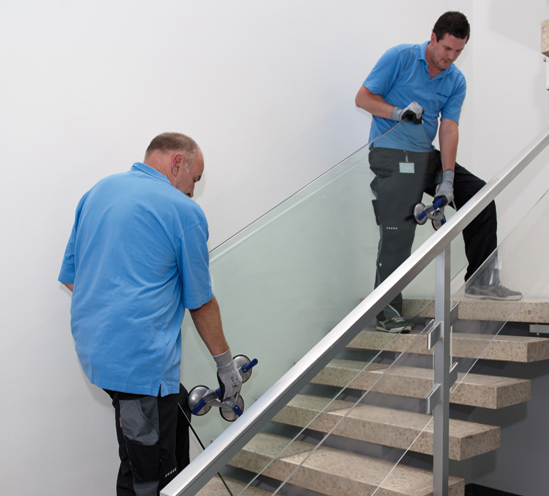Suction lifter
A suction lifter (or suction pad) is a form of suction cup used for commercial and industrial lifting operations. In the construction industry, they are often used to move large, smooth objects such as glass panes, fixtures such as kitchen countertops, floor tiles, and so on. They are commonly hand-operated, although they can also operate on a hoist.
Suction lifters follow the same principle as a suction cup, maintaining a vacuum between the surface to be lifted and a flexible material such as rubber. The vacuum is created by pushing a lever or handle on the suction cup.
Their load carrying capacity is dependent on the type, size and number of suction cups, and the lifting mechanism. Typical safe working loads for hand operated suction lifters range from 10kg to 60kg per lifter, with lifters formed from 1 to 4 suction cups. Hoist operated lifters can have from 1 to 50 or more suction cups and can lift well in excess of 1,000kg.
They work best against very flat, smooth surfaces, but can also be congfigured to lift other shapes, such as curves. Rougher textured surfaces make the maintaining of a vacuum more difficult
Lower atmospheric pressures also make it more difficult to stick to surfaces.
[edit] Find out more
[edit] Related articles on Designing Buildings Wiki
Featured articles and news
The history of building regulations
A story of belated action in response to crisis.
Moisture, fire safety and emerging trends in living walls
How wet is your wall?
Current policy explained and newly published consultation by the UK and Welsh Governments.
British architecture 1919–39. Book review.
Conservation of listed prefabs in Moseley.
Energy industry calls for urgent reform.
Heritage staff wellbeing at work survey.
A five minute introduction.
50th Golden anniversary ECA Edmundson apprentice award
Showcasing the very best electrotechnical and engineering services for half a century.
Welsh government consults on HRBs and reg changes
Seeking feedback on a new regulatory regime and a broad range of issues.
CIOB Client Guide (2nd edition) March 2025
Free download covering statutory dutyholder roles under the Building Safety Act and much more.
AI and automation in 3D modelling and spatial design
Can almost half of design development tasks be automated?
Minister quizzed, as responsibility transfers to MHCLG and BSR publishes new building control guidance.
UK environmental regulations reform 2025
Amid wider new approaches to ensure regulators and regulation support growth.
The maintenance challenge of tenements.
BSRIA Statutory Compliance Inspection Checklist
BG80/2025 now significantly updated to include requirements related to important changes in legislation.























